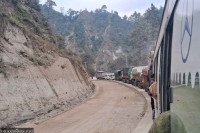Opinion
Sense of an ending
With the recent devastation of the historic national heritages, I have now developed a new sense of loss
Darshan Karki
This is undoubtedly the worst possible time to admit this. But given the times we are living in, there is no better time to acknowledge it.
I have always felt uneasy with the portrayal of the Kathmandu Durbar Square as the face of Kathmandu. Not that I have not spent innumerable mornings, afternoons and evenings loitering aimlessly at the Square. It is not as if I have not spent many hours sitting at the Maju Deval facing different directions depending on my mood either: facing the buildings behind when not in the mood to look at people, a different side not to disturb lovers or just staring ahead at the people, feeling the wind and watching life go by. On different steps of the Deval and the surrounding temples, I have met different friends to discuss different issues: a career, development, relationships and death, and unwillingly gulped down many cups of tea.
Still, my question has always remained: must we always justify our love of Kathmandu in relation to the cup of tea we sipped on the steps of the Laxmi Narayan temple? Does all writing about Kathmandu have to justify one's love of the Durbar Square or situate itself in the alleys of Asan? What about the Kathmandu beyond the stretch of the stone-paved path from Juddha Salik to a temple called the small Pasupatinath? On other days, when discussion on Twitter inadvertently veered towards accusing 'Kathmandu' of not doing this or that, I have wondered what Kathmandu is. Is it a collection of white buildings inside Singha Durbar? Is it Baluwatar? Or is it the millions that live in tiny rented rooms in the city or migrants from elsewhere who now have a ghar in Kathmandu? Can the city be what it is by excluding any one of these?
But when I first saw Dharahara missing from the city's landscape, I was very clear as to what Kathmandu is or was.
While the building could still be spotted from the various hills surrounding the Valley, in Sundhara, Dharahara seemed to be restricted to a tiny area, of late. Unlike the Durbar Square which remained a vibrant site, in the past few years, Dharahara had to compete for attention after being surrounded by ugly, tall structures. Even when it did make the news sometime back, when CPN-UML leader KP Oli climbed the building, the focus was solely on the person, not the building. The structure, it seemed, had resigned to its fate of being left in the background.
Its collapse has now put it back in limelight.
The truth is, all my life, ever since I have known that a huge earthquake was 'supposed' to occur in the country in about every eight decades, I have imagined its horrors in great detail. Maybe I would make it through the devastation, maybe I would not. But the city would reclaim its beauty and rise from the ashes of its destruction. In any case, the future of Kathmandu was bright, in my head, though many of its citizens might not be a part of it.
What did actually happen, however, was beyond anything I had imagined. After all, much narrative about death and destruction in Kathmandu, prior to the quake, largely focused on its haphazard urbanisation, its concrete jungle which is largely an outcome of flouting building codes. Against vivid descriptions of the horrifying fate awaiting such structures, the possible collapse of the Valley's historical monuments faded in the background.
The collapse of Dharahara and the destruction of the Kathmandu Durbar Square now mark an end of the history of the city and the start of another. The Saturday quake turned out to be far beyond what I had imagined of the great shake. That which made Kathmandu beautiful is largely gone, and it feels as though their absence is the strongest mark of their presence.
The experience of the quake
Two years ago, when Kathmandu experienced a mild tremor, my first reaction to the quake was 'I need to tweet'. On Saturday, when the great earthquake struck Kathmandu, that is precisely what I did, again. This time, to my disbelief, the internet on my NTC number was working even though I couldn't call anyone.
On that fateful day, I was in the middle of an interview with a Nepali Congress (NC) leader who was telling me how the rumours that the party president and Prime Minister Sushil Koirala was seeking to elongate the constitution-writing process until after the party convention were baseless. Then, he said, “There’s an earthquake” and rushed towards the door. I followed. It seemed to take forever to even get to the door as the ground began shaking like crazy. I lost my balance as soon as I reached the grass lawn outside. In retrospect, I might have even grinned as I did an involuntary somersault because it was an incredulous situation to be in. To have gone there to learn the dull details of constitution writing and then to be rolling on the ground.
I had gone to discuss the relation of the state with its people, which before the earthquake, centered on the promulgation of the constitution by those elected to power. Outside, the very basis of the relationship, the citizens of the country, buried under rubble and languishing in tents, were reeling under the marked absence of the state
Karki is with the op-ed desk at the Post




 6.3200000000001°C Kathmandu
6.3200000000001°C Kathmandu












